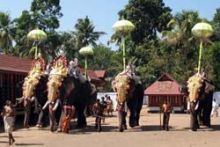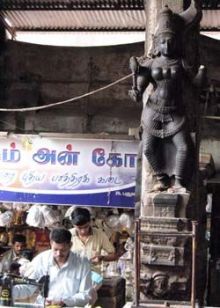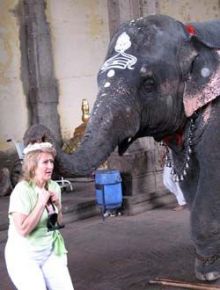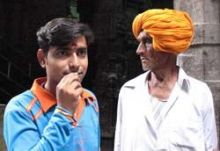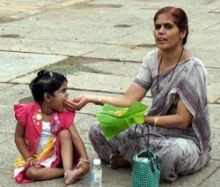Delhi at night greeted our plane with drizzling rain and mist, which reminded us of the past Ukrainian autumn. Then we headed for the state of Kerala. Translated from the local Malayalam language, it means “paradise on earth.” Imagine a limitless ocean, a pristine sandy beach, or gentle wave that can still deal you a staggering blow. Slender coconut trees, taller than our pine trees and illuminated by the sun setting beyond the watery horizon, are ready to heap hundreds of tons of their lush fruits onto the residents of this paradise. Coconuts sometimes fall to the ground without breaking and roll towards the waves. Legend has it that Adam and Eve settled in this very place. In Kerala you begin to believe this.
Is this perhaps why St. Thomas (also popularly known as Doubting Thomas) preached here? He is buried here in Kerala. With its famous inland waterways, it is easier to understand the meaning and importance of the legend from the Gospels about how people were given fishing rods instead of fish. We watched fishermen rhythmically chanting as they dropped a huge mast attached to a net into the sea from a makeshift pier and then lifted their catch — quite big by our standards. Thousands of years ago, the Chinese brought this technique when they were fishing in the waters of the Arabian Sea.
Ever since then, time seems to have stood still, except today the boats of Kerala are equipped with motors. But just like hundreds of years ago, traders and dealers are waiting for the fish on the shore. The fishermen throw loads of this wriggling silver out of their wicker baskets. The two sides begin to bargain vigorously. The unruffled auctioneer cheerfully keeps track of the bidding, while the dealers make their bids furiously. The highest bidder immediately takes his batch, and his men sprinkle it with chipped ice.
Fish is a very important food in Kerala because Hindus do not eat beef, while Muslims, who are also very numerous here, avoid pork. To a large extent, the Hindu caste system helped spread Islam and Christianity on the Indian subcontinent. Lowest-caste people (especially untouchables, who were oppressed and humiliated) were told: convert to Islam and you will be equal to all the other faithful. India practices so- called moderate Islam: believers go to a mosque in the morning and a Hindu temple in the evening.
Today the caste system has been formally abolished, and untouchable schoolchildren no longer sit behind a special curtain. But in real life, especially in the countryside, the caste division still exists. It plays into the hands of politicians, who find it easier to manipulate the votes of a credulous electorate.
Our impression was that Indians are openhearted and extremely friendly people. Wherever we drove or walked, people would greet us cheerfully and sometimes even come up to us and shake hands, and in a somewhat ceremonious but sincere way, look us right in the eyes. Of course, the language barrier thwarted all our attempts to communicate with them (in addition to two national languages, there are upwards of 20 regional official languages in India).
Naturally, not everyone took notice of us. Like in any other country, everybody here is preoccupied with their own problems. In spite of its impressive economic progress, India is still a poor, disorganized, and not very clean country. Whereas the allegedly uncorrupt police are still trying to combat corruption, the authorities still have not tackled public hygiene in cities. This seems to be the main reason why India has not turned into a true paradise on earth for tourists, to which all Indian states and union territories can lay claim. At first glance, this is so easy to do: just pick up the garbage, which does not seem to be removed even in India’s capital, improve the roads a bit, build a sufficient number of hotels, lay sidewalks and street lights (we saw them only in Delhi), and put more garbage cans on the streets as an element of public education. But who will advise the Indians on what to do with their holy cows, and will they heed this advice? Theirs is a different country and a different civilization, and they are used to living this way, so they probably find it difficult to understand why they should do things differently.
Yet as time passes, these questions will obviously be given top-priority attention. The three hotels where we stayed did not have a star rating, but the service, cleanliness, and comfort were at the level of three-to-four-star Turkish and even Italian hotels, while bungalows in Aleppi, 10 km from the Arabian Sea, which look as though they were built long ago, were simply magnificent, as were the superb beaches, where the lifeguards were stern policemen.
Today the local authorities are preoccupied with investing all available resources in human capital. Education in India, with its multi-billion population, is free, and its growth rate is one of the highest in the world. We were told that in Kerala everyone who really wants to continue their education is given financial aid pegged to their economic situation. Every now and then we saw crowds of Indian schoolchildren dressed in nice uniforms. They were cheerful and did not look hungry. Sometimes preschoolers came up to us, asking us, oddly enough, for pens, not money. If we had known that there are so many children who want to become literate, we would have brought a big supply with us.
Our tour was wonderfully organized. The Indian connoisseur Volodymyr Kuleshov, who acted as the guide and captain of our journey, did his utmost to ensure that we Ukrainian journalists got as complete a picture of India as possible in a matter of days. We saw rice paddies, tea plantations, and groves of hevea, a rubber tree whose sap provides latex and wood used in crafting superb furniture. But how can you understand a country if you cannot mix with its people? At our request, we were introduced to an ordinary Kerala farmer. Abraham Kallummakal, a Catholic (20 percent of this state’s population prays in a variety of Christian churches) and third-generation kitchen gardener, is the owner of a family-run farm called Abraham’s Spice Garden. The two hectares that he inherited from his grandfather and father, which at first glance resemble a jungle, are planted with spices, the pride of India, and Kerala in particular. India is the world’s leading spice-producing country, accounting for 80 percent of the world’s supply of cardamom. The farmer showed us pepper (small green berries on a liana), cardamom, cinnamon, and coffee and cocoa beans. He treated us to delicious bananas called lady’s fingers (“our” bananas are no patch on these) and gave us some seeds with the assurance that they will sprout in our country.
The Day asked him about his business. Abraham is satisfied: everything is OK, he said. He praised the state government (led by the communists for the last 50 years), which does not tax small- scale farmers. This has brought success to his business in which his father and son are also involved. His modest house looked neat, and inside it resembled a Ukrainian peasant house: it is clean, and the walls are whitewashed and hung with a photograph of his late mother, but there is no sign of conspicuous wealth.
Abraham also has three daughters, one of whom goes to elementary school. The other two are students at US universities. Our Indian guide Manush said later that Kerala has the highest living standard and the longest life expectancy in India. Asked by The Day if foreign investors are scared off by the communist government, he said no, adding that stability is what attracts people to Kerala. A container terminal was recently built in the port of Cochi. Wealthy people from the United Arab Emirates are establishing a computer center here. According to Manush, the communists have turned into businessmen. Their ideas only figure on posters and remain deep inside them, he added.
But why is such a beautiful country like India still so poor? One of the factors is the very high birth rate. India long ago surpassed China’s birth rate, and according to some forecasts, the population of India may well catch up with China’s. This is obvious even without the statistics: the city streets are packed with people even on weekdays. Former Prime Minister Indira Gandhi tried to curb the high birth rate. Families that toed the government’s demographic line were eligible by a special law for a free transistor radio, which at the time was considered a technological wonder. The government also encouraged whistle-blowers to inform on families that were too large. Couples were summoned to “explanatory interviews.” If this failed to produce results, extreme measures were often adopted. It is said that one of the prime minister’s sons even formed special units to forcibly sterilize men. Ukraine is not the only country with a dark history. So does India, which calls itself the world’s largest democracy and has produced many world-famous thinkers, including six Nobel Prize winners.
India’s ancient history is still not fully researched and is often supplanted by religious myths. The age of one temple or another is often unknown. There are not so many of them left in India. We had the pleasure of visiting one of them, the Meenakshi Temple in Madurai. This is a large religious complex rather than just a temple. It is an entirely different religion and culture, and is characterized by different colors, sculptures, and architecture. The grandeur of Meenakshi’s temples and towers and its impressive creative spirit and industry of its architects, sculptors and masters who created this brightly-painted granite wonder reminded me of the Vatican.
The theme of the temple is a naive but luminous legend of cathartic love. For a long time, a family had no children. At last a daughter was born. But when she grew up, her parents were surprised to see that she had three breasts instead of two. Who on earth would marry their offspring with a defect like this? So they turned to the gods for help. The gods comforted them, saying that when the daughter finds her eligible young man and they love each other, everything will take the right shape — which is, of course, what happened. Our heroine’s eligible young man was none other than the god Shiva, while she turned out to be an avatar of his wife Parvati. The Meenakshi Temple complex, built in their honor, fires the imagination and brilliantly recounts this story as well as other Hindu postulates, legends, and myths. The Hindu pantheon includes 333,333,333 gods. We were surprised not to see a three-breasted girl either in the temple (tourists are not allowed into the part where believers pray) or on the 13 sculpture-studded towers. We asked the omniscient Manush for an explanation. After some hesitation, he quickly led me into the temple’s other wing, which houses a bazaar and sewing workshops. The only three-breasted granite goddess in the entire complex looked very sexy, I must admit. If she were living in today’s society, she could take pride in her physical shortcomings. But there would not have been a legend, and the temple complex, where a real Indian elephant blessed us by smoothly stroking our heads, would not have been built.
It is not mandatory for Hindu temples to attract the faithful with their antiquity and majestic architecture. On the way to the airport we saw fireworks in broad daylight, multicolored umbrellas on top of elephants’ backs, and heard music and songs. We grabbed our cameras, got off the bus, and ran to a temple, which was actually a canopy supported by massive columns. Inside there was a line of six or seven elephants, their gold decorations sparkling in the sun. They were surrounded by many festival- goers, who were beating drums and blowing into semi-circular bow-shaped musical instruments. Spectators were walking barefooted on the red-hot sand or sitting in the shade on benches surrounding the canopy. At last the elephants, steered by crews on their backs, lined up and went marching solemnly around the temple. We ran behind and in front of them, oblivious to the fact that our bare feet could have been turned into mincemeat. This was the last brilliant and emotional gift that India presented to its Ukrainian guests. India will always be a part of us, this mysterious yet open country that you simply cannot leave behind.

